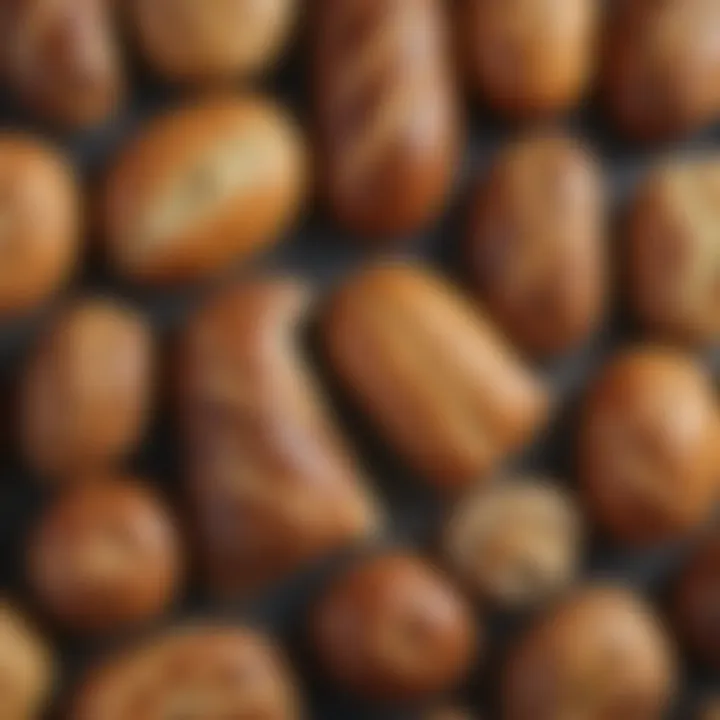Calories in a Slice of Bread: A Comprehensive Analysis


Intro
When considering the dietary choices we make, the caloric content of bread often merits meticulous investigation. Varieties of bread—ranging from sourdough to whole grain—supply varying amounts of calories and nutrients. Understanding these elements is crucial for anyone attempting to manage their weight or improve their overall nutrition. The following sections will explore the calorie content present in different types of bread, offering insights into their nutritional profiles and impact on dietary preferences. This exploration can assist busy professionals and culinary enthusiasts alike in making informed choices with regard to bread consumption.
Bread Varieties and Their Caloric Content
It's essential to recognize that bread comes in diverse forms, each with a distinct caloric value. A slice of standard white bread generally contains around 70 to 80 calories. In contrast, whole grain bread commonly provides slightly more, typically in the range of 80 to 100 calories per slice. Artisan breads, such as ciabatta or focaccia, can exceed these ranges, sometimes reaching up to 120 calories per slice depending on ingredients and serving sizes.
In examining the calorie content, it is also important to consider that specialty breads like gluten-free varieties may contain more calories due to the use of alternative flours, such as almond or rice flour.
"Understanding the caloric makeup of bread is fundamental for those seeking to balance enjoyment of food with health concerns."
Factors Influencing Caloric Content
Several factors contribute to the caloric content in a slice of bread.
- Ingredients Used: The specific ingredients play a pivotal role; breads made with added sugars, fats, or dairy typically exhibit higher calorie counts.
- Portion Size: The bread slice’s thickness also matters. A thicker slice obviously contains more calories.
- Nutritional Enhancements: Breads enriched with seeds or grains may not only be higher in calorie count but also in nutritional value, such as fiber and healthy fats.
Nutritional Profile Breakdown
Diving deeper into bread's structure reveals its macronutrient composition. Aero bread commonly combines roughly 70-75% carbohydrates, 5-12% proteins, and about 1-3% fats. Additionally, bread can contain beneficial nutrients like fiber, vitamins, and minerals, which vary significantly according to its type. Whole grain and seeded breads typically provide higher fiber content, along with essential minerals like iron and magnesium.
Implications for Dietary Choices
Understanding the caloric and nutritional aspects of bread is important for making dietary choices. For those on calorie-conscious diets, choosing whole grain or lower calorie options is advisable, as they tend to provide sustained energy without excessive caloric overload. Furthermore, incorporating bread into your meal plan can add variety, but moderation is key. Special attention should be paid to bread servings, particularly when pairing with calorie-dense spreads and toppings.
In summary, a comprehensive analysis of calories in a slice of bread exposes truths necessary for informed dietary choices, empowering readers to navigate their culinary pursuits with knowledge and awareness.
Understanding Bread Composition
Understanding bread composition is crucial for assessing its caloric content and nutritional value. Bread is a staple food in many diets worldwide, making its ingredient list and preparation methods highly relevant. By exploring the key components of bread, one gains insight into what contributes to its caloric density and nutritional aspects.
Basic Ingredients
Bread typically consists of a few fundamental ingredients: flour, water, salt, and yeast. Flour is the primary source of carbohydrates, which are essential for energy. Water is vital for hydration and supporting gluten formation, while salt enhances flavor and regulates fermentation. The role of yeast, a live organism, is to ferment sugars in the flour, producing carbon dioxide and allowing the dough to rise. Together, these ingredients combine to create the familiar texture and structure of bread. Understanding these components helps consumers make informed choices, especially for those monitoring their caloric intake.
Types of Flour Used
The type of flour used in bread significantly impacts its nutritional profile. Common flours include all-purpose, whole wheat, rye, and gluten-free variations. Each flour has its unique set of nutrients:
- All-purpose flour: Made from refined wheat, it often lacks fiber and essential nutrients.
- Whole wheat flour: Retains the bran and germ from the wheat grain, which provides more vitamins, minerals, and fiber.
- Rye flour: Known for its robust flavor, it is often denser and may offer higher fiber content than wheat flour.
- Gluten-free alternatives: Such as almond, coconut, or rice flour, provide options for those with gluten intolerance.
These flour types affect not only the caloric content but also the glycemic index and overall health benefits of the bread. Thus, knowing the flour type can guide consumers towards healthier choices.


Role of Yeast in Bread
Yeast plays a critical role in bread making, influencing its texture and volume. Through fermentation, yeast converts sugars into alcohol and carbon dioxide. This process aerates the dough, creating the light, airy structure that is characteristic of many bread types. Additionally, yeast contributes to the flavor development of the bread, giving it a distinctive taste. Different strains of yeast can also lead to variations in acidity and aroma, particularly in specialty breads like sourdough. Understanding the role of yeast is essential, especially for those interested in artisanal bread-making or those seeking to understand how various bread types might interact with their digestive systems.
"Bread is not merely a source of calories. It is a complex food that can offer various health benefits depending on its composition."
Caloric Content of Different Bread Types
Understanding the caloric content of various bread types is crucial for anyone looking to manage their diet consciously. Each type of bread offers different nutritional profiles that can significantly affect one's caloric intake. Consumers often choose bread based on taste, but the caloric component should equally weigh in decision-making. Knowing the specific calories in different bread types helps individuals align their consumption with personal health goals and dietary requirements.
White Bread
White bread is one of the most prevalent bread choices worldwide. It is typically made from refined flour, which has undergone a milling process that removes the bran and germ from the wheat. This results in a softer texture and lighter color.
However, the refining process diminishes the nutritional value as it strips away fiber and essential nutrients. A standard slice of white bread usually contains about 70 to 80 calories. While it may be pleasing for taste, its low fiber content can lead to quicker hunger pangs, thus possibly leading to overeating later.
Whole Wheat Bread
Whole wheat bread is often deemed a healthier alternative to white bread. It utilizes the entire wheat grain, thus preserving more of its natural nutrients. A slice typically contains around 80 to 90 calories. The higher fiber content helps to regulate digestion and can promote satiety, which is beneficial for weight management. The presence of whole grains also adds vitamins and minerals, making it a preferable option for health-conscious consumers.
Rye Bread
Rye bread offers a distinctive flavor profile and a denser texture. Commonly made from rye flour, it usually has a slightly lower caloric content than white bread, averaging about 75 to 85 calories per slice. Rye bread contains various nutrients, including B vitamins and minerals. The complex carbohydrates in rye can assist in maintaining blood sugar levels, which can be crucial for individuals monitoring their glucose intake.
Sourdough Bread
Sourdough bread is unique in its fermentation process, which involves naturally occurring bacteria and yeast. This method not only adds to its distinct tangy flavor but can also enhance its nutritional benefits. A slice of sourdough typically contains around 90 calories. Its fermentation leads to improved digestibility, resulting in a different glycemic impact compared to other bread types. Consumers often find sourdough to be more satisfying, helping in moderation of intake.
Gluten-Free Bread
Gluten-free bread serves those with celiac disease or gluten sensitivity. It is usually made from alternative flours, such as almond or coconut. The caloric content can vary widely but generally ranges from 90 to 120 calories per slice. While gluten-free options can be important for health reasons, they may not always provide the same nutritional benefits as traditional whole grain bread. Consumers should read labels carefully to understand what they are consuming.
Portion Sizes and Their Impact
Understanding portion sizes is essential when evaluating the caloric content of bread. Bread comes in various shapes and sizes, and how much we eat dictates the total calorie intake. A standard slice of bread may contain around 70 to 100 calories, but thick slices can easily double that. For those mindful of their caloric intake, being aware of portion sizes is crucial.
Standard Slice vs. Thicker Slices
The difference between a standard slice of bread and a thicker slice is significant. A standard slice, often around 28 grams, provides a predictable amount of calories. For example, a slice of white bread from a loaf may contain about 80 calories. In contrast, a thicker slice could weigh up to 50% more, leading to a caloric content of at least 120 calories or more.
Thicker slices may seem more satisfying, but they also pack more calories, fats, and carbohydrates. Understanding this difference can help individuals control their intake and adjust according to their dietary goals. Consumption patterns should also reflect awareness of these differences.
Effect of Bread Density
Bread density refers to how tightly packed the ingredients are within the slice. Denser bread types, such as whole grain or artisanal varieties, usually have a higher caloric content than lighter ones like white or fluffy bread. This density means that even a small slice can hold more calories.


For instance, a slice of dense whole grain bread often boasts more fiber, protein, and micronutrients, which contributes to a greater caloric value. On the other hand, lighter bread may lack these qualities yet still deliver a satisfying texture.
Understanding bread density not only aids in managing caloric intake but also helps in making informed food choices based on nutritional value. Dense breads can contribute positively to a meal plan focused on fiber and nutrients, while also affecting satiety and overall dietary satisfaction.
"Being conscious of portion sizes and bread density allows individuals to make better dietary decisions without compromising satisfaction."
In summary, recognizing the impact of portion sizes and bread density is vital for anyone looking to manage their calorie intake. This awareness helps in making informed choices that align with personal dietary goals.
Nutritional Aspects of Bread
The nutritional aspects of bread are critical when discussing its place in a balanced diet. Bread provides not just calories, but also a range of macro and micronutrients essential for good health. For culinary enthusiasts and health-conscious individuals alike, understanding these components aids in making informed dietary choices. Moreover, the nutritional profile can vary significantly based on the type of flour used, the addition of seeds or grains, and other ingredients. Evaluating these aspects allows for a better comprehension of how bread can fit into one's nutritional intake.
Macronutrients in Bread
Bread is primarily composed of three macronutrients: carbohydrates, proteins, and fats. The predominant macronutrient is carbohydrates, which provide energy necessary for daily functions. A typical slice of white bread contains around 12 to 15 grams of carbohydrates. On the other hand, whole wheat bread boasts more complex carbohydrates, offering approximately 15 to 18 grams per slice.
- Carbohydrates are crucial for energy.
- Proteins in bread contribute to muscle repair and growth, with sources like whole wheat containing about 2 to 4 grams of protein per slice.
- Fats are often minimal in most plain breads, with a typical slice containing around 0.5 to 1 gram, unless seeds or added fats are included in the recipe.
These macro components highlight the role of bread as a source of quick energy while also providing some essential building blocks for bodily functions.
Vitamins and Minerals
Bread can be a source of essential vitamins and minerals, depending on its ingredients and processing. For instance, whole grain breads retain higher amounts of nutrients compared to refined options. Some important vitamins found in bread include B vitamins such as niacin, thiamine, and riboflavin, which are vital for energy metabolism. Proximity in the cooking process can also affect the vitamin content.
Critical minerals such as iron, magnesium, and selenium are present in various types of bread. Whole grain varieties are particularly rich in magnesium, which supports several biochemical reactions in the body.
Fiber Content in Different Types
Fiber is an essential component found in bread that supports digestive health. The type of bread directly affects its fiber content. Whole grain or whole wheat breads provide a higher fiber content, often ranging from 2 to 4 grams per slice.
- Whole Wheat Bread: This variety typically has more than 3 grams of fiber per slice, beneficial for promoting satiety and digestive health.
- White Bread: Generally low in fiber, white bread may contain less than 1 gram per slice due to the refining process that removes the bran and germ, which are fiber-rich parts of the grain.
- Rye Bread: Depending on the variety, rye can provide around 2 grams of fiber per slice, contributing to balanced digestion.
Fiber plays a significant role in preventing constipation and regulating blood sugar levels. Thus, incorporating fiber-rich bread options can lead to better overall health outcomes.
Health Considerations
Understanding the health considerations related to bread consumption is vital for anyone aiming for a balanced diet. Bread can offer both benefits and challenges depending on its type and portions. Many individuals do not recognize how their choices in bread can influence overall health, including weight management and blood sugar levels. This section connects these dots and provides practical insights for making wise decisions.
Impact of Bread on Weight Management
When it comes to weight management, the role of bread in the diet can be complex. Bread, often characterized by its carbohydrate content, provides energy but can also contribute to excess caloric intake if consumed in large quantities. Choosing the right type of bread is essential for those managing their weight. Whole grain options, such as whole wheat or rye, tend to be more satiating than white varieties due to their higher fiber content. Eating bread with high fiber can slow digestion and help maintain a sense of fullness, thus potentially reducing overall calorie intake.
However, the specific impact of bread on weight can vary with portion sizes and frequency of consumption. For instance, individuals incorporating moderate amounts of whole grain bread into a balanced diet may find it beneficial for weight control, while those who frequently consume large portions of high-calorie white bread might experience weight gain. This relationship emphasizes the importance of being mindful about bread selections and servings.


Bread and Blood Sugar Levels
Blood sugar regulation is another critical aspect affected by bread consumption. Different types of bread behave differently in terms of how they influence blood sugar levels. White bread, made from refined flour, is known to cause a rapid spike in blood sugar shortly after consumption. This happens because it contains fewer fibers and nutrients compared to whole grain breads.
In contrast, whole grain breads, such as those made from whole wheat or oats, have a lower glycemic index. This means they lead to a more gradual release of sugar into the bloodstream, which can help in maintaining more stable blood sugar levels. For individuals with insulin sensitivity or diabetes, opting for low-glycemic bread is an important consideration.
In summary, bread can be part of a healthy diet when chosen wisely. By understanding its impact on weight and blood sugar levels, one can make better dietary choices. Educating oneself on these aspects helps individuals integrate bread into their meals without compromising their health goals.
The type of bread chosen and how much is consumed plays a crucial role in weight management and blood sugar regulation.
Recommendations for Bread Consumption
Understanding how to consume bread effectively is critical for maintaining a well-balanced diet. While bread can be a source of valuable nutrients, its caloric content can vary significantly depending on the type and portion size. This section will explore important recommendations that can help readers make better dietary choices related to bread consumption.
Balancing Bread with Other Foods
Integrating bread into your meals requires a thoughtful approach. It is essential to pair bread with other food groups to achieve a balanced plate. This means considering not only the quantity of bread but also what you eat alongside it.
- Protein Sources: Including proteins like chicken, fish, or legumes can enhance satiety. These foods help stabilize blood sugar levels, which may counterbalance the potential spike from carbohydrate-rich bread.
- Vegetables: Adding a variety of vegetables contributes vitamins, minerals, and fiber while keeping overall calorie intake in check. Consider a sandwich loaded with leafy greens or a side of steamed broccoli with your meal.
- Healthy Fats: Incorporating healthy fats from sources like avocados or olive oil can promote fullness. A smear of avocado or a dressing with olive oil can enhance flavors while providing essential nutrients.
Overall, bread should not be viewed in isolation. Instead, it should complement a varied and balanced diet, providing flavor while ensuring adequate nutrition without excessive caloric intake.
When to Opt for Whole Grain Over White
The choice between whole grain and white bread is not merely a matter of taste but of nutritional value as well. Whole grain bread has several advantages over its white counterpart that warrant consideration.
- Higher Nutritional Value: Whole grain bread contains more fiber, vitamins, and minerals compared to white bread. Fiber is essential for digestive health and can help in regulating blood sugar levels.
- Better Satiety: The higher fiber content in whole grain bread can lead to increased feelings of fullness. This can assist in weight management and overconsumption of calories.
- Lower Glycemic Index: Whole grain options typically have a lower glycemic index. This means they are digested slowly, leading to a more gradual increase in blood sugar levels. This can be particularly beneficial for individuals managing diabetes.
Choosing whole grain bread can provide long-term health benefits and support better dietary patterns.
End and Final Thoughts
Understanding the caloric content and nutritional profile of bread is essential in today's health-conscious society. This article has dissected various aspects of bread consumption, from ingredient composition to portion sizes, providing valuable insights. The debate surrounding bread's health benefits or drawbacks can often cloud decision-making, yet knowledge equips individuals to navigate this complexity effectively.
Integrating Bread Mindfully into Your Diet
Incorporating bread into your daily meals requires a balanced approach. It’s crucial to consider the type of bread that best aligns with your dietary goals. Whole grain varieties tend to offer more nutrients and fiber compared to their white counterparts. Mindful consumption means paying attention to portion sizes, as consuming thicker slices can significantly increase caloric intake.
To achieve a healthier diet, aim for a mix of whole grains, incorporating them as part of a balanced meal. Pairing bread with protein, healthy fats, and vegetables can create a more satisfying dish and optimize nutritional benefits. By understanding your body’s response to different types of bread, you can make decisions that complement your health objectives.
Encouraging Informed Dietary Choices
Making informed dietary choices is not just about counting calories. It involves understanding the broader nutritional implications of your food choices. For bread enthusiasts, this means recognizing how different types influence health markers like blood sugar and satiety.
Staying informed can be as simple as reading ingredient labels and focusing on whole food options. Engaging with reputable resources, such as nutrition-focused websites, can broaden your understanding further. Additionally, discussions and communities on platforms like Reddit or Facebook about bread and nutrition can provide real-world advice and support.
Ultimately, enhancing your knowledge about bread can lead to healthier choices, making each slice of bread count towards your overall well-being.
"Knowledge is the first step toward making healthier choices."
By appreciating the details laid out in this article, you’re better equipped to navigate your dietary journey with confidence.







